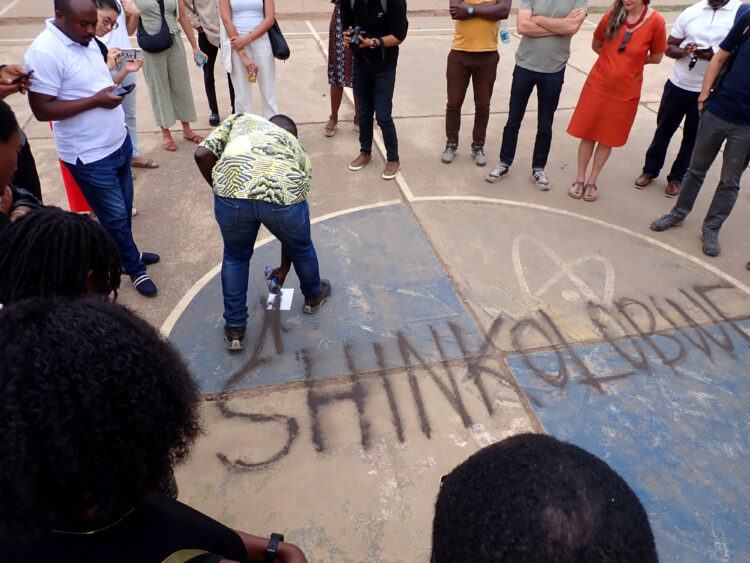

参加無料
要予約(定員10名)
ご予約はこちらのフォームよりお願いします
https://forms.gle/xpiyzxFHmSM8e3GW8
『Shinkolobwe: Between Power and Memory / シンコロブウェ:権力と記憶のはざま』は、コンゴ民主共和国、アメリカ、日本出身の3人のアーティストによる芸術的対話。コンゴのシンコロブウェウラン鉱山の歴史を、多分野にわたる視点から考察する。
シンコロブウェ鉱山(当時ベルギー植民地領)は、1945年に広島と長崎に投下された原子爆弾に使用されたウランの主要産出地であった。この鉱山はそれまでに発見されたものとは比較にならないほどの高濃度のウラン鉱石を埋蔵しており、その驚異的なパワーによって、アメリカはわずか3年という短期間で人類初の原子爆弾を開発、爆発することを可能とした。そしてさらに数千発という核兵器を続けて製造した。マンハッタン計画と冷戦初期、ベルギーはシンコロブウェ鉱山から数千トンのウラン鉱石をアメリカに売却した。鉱山に関する情報は厳重に秘密にされ、その名前はニュース報道や地図からも削除された。同時に、ウラン採掘者らの話や労働実態や健康被害も歴史から削除された。シンコロブウェ鉱山は少なくとも冷戦はじめの10年間、核兵器製造だけでなく西側連合による原子力産業全体の発展の源であった。『 シンコロブウェ:権力と記憶のはざま』に関わるアーティストらは、第二次世界大戦の核の歴史とその後の影響を、文化的、生態学的、政治的に多様な視点から再考する。
主な展示作品:ロジャー・ピートの版画地図は、マンハッタン計画の産業インフラによって、シンコロブウェのウラン鉱石が地球上どこをどのように通過したかを提示する。鉱山会社ユニオン・ミニエール社が発行したシンコロブエ鉱山の絵葉書の上に描かれた竹内としえのドローイングは、歴史上抹殺されたウラン採掘者や彼らの家族を想像し、日本とコンゴが共有する放射能被害の記憶を浮き彫りにする。そしてシクテ・カキンダのアニメーションビデオは、コンゴと広島の「つながり」を主題とし、ウラン採掘からはじまり、アメリカにおけるウラン加工を経て、広島に投下されるまでの時系列をたどる。
これらプロジェクトの中心は、当鉱山にまつわる物語とそれに伴う影響。誰がこの物語を語り、誰がこの物語を聞くのか、そして現代世界を生み出した破壊と搾取の歴史において、これら3カ国がどのように結びついているか、である。

アーティスト経歴
Sixte Kakinda (シクステ・カキンダ)
コンゴ出身のアーティスト。現在、武力勢力M23がGomaを支配して以来、ウガンダのカンパラに在住。
独学で漫画家としての活動を始め、東京藝術大学大学院美術研究科グローバルアートプラクティス専攻修士課程(2020年)、博士課程(2023年)を修了。彼の作品「Intimate Moments/Monologue」は最優秀賞を受賞。
カキンダはドローイングの基本要素である「線」ー 特に植民地時代以前からコンゴ川流域に引かれてきた線に強い関心を寄せる。「線」が本来持っている性質、例えば接続性、分離性、幽閉性、不可視性、同一性、を活かすことで、芸術創作の新たな可能性を探る。またそれにより、コンゴの歴史的、文化的な物語についての対話を深めることを目指している。彼のアプローチは、ドローイングと描くという行為を脱植民地化し、コンゴのアイデンティティとその歴史をよりニュアンスある形で表現することを目指している。これは「交差としてのドローイング」のような概念につながり、彼の芸術活動の中で発展し続けている。
カキンダは2020年にgallery Gで個展を開催。Apexart gallery(アメリカ)、MARKK(ドイツ)、タメンタイギャラリー(日本)、シノチカ(日本)、Art Park gallery(韓国)、ライプツィヒ現代美術館(ドイツ)、M HKA(イギリス)などのグループ展に参加。KLA ART 24フェスティバルなどいくつかのアート・レジデンスに参加し、Sinzo Aanza、Lindiwe Matshikiza、鈴木ヒラクなどのアーティストとコラボレーションしている。
https://dsixte.wixsite.com/sixte-kakinda, https://www.instagram.com/x.d.lab/
Roger Peet (ロジャー・ピート)
米国オレゴン州ポートランド在住のアーティスト、版画家、壁画家、執筆家。ロジャーの作品は、文明の思い違い、捕食者と被食者の関係、現代の生物多様性における危機、そして資本主義、それらに対して何ができ、何ができないか、に焦点を当てる。執筆活動では、政治と社会と自然界との関係性の歴史を扱う。ロジャーはJustseeds Artists’ Cooperativeの創設メンバーであり、ポートランドにあるFlight 64という共同プリントスタジオの運営に携わっている。より寛大で、より野生的な世界を目指し、世界各地やポートランド地元でアーティスト、活動家、科学者とコラボレーションを行う。
https://www.instagram.com/toosphexy/
https://toosphexy.carrd.co/#
竹内としえ/トシ・モシ Toshie Takeuchi/Toshi Moshi
ビジュアルアーティスト、映像作家、コミュニティアート活動のオーガナイザー。愛知県生まれ。20数年ほどヨーロッパを転々とし、現在デンマークのコペンハーゲンで活動中。アーカイブの研究とフィールドワークを基盤とし、他のアーティスト、研究者、地域コミュニティなどと協働をし、特にワークショップを共通の創造的手段としながら制作をしている。彼女の作品は、写真、映画、ドローイング、パフォーマンス、凧作りなど多様なメディアを用い表現され、コミュニティの持つ力強さを通じて、治癒、回復、希望を追求する。竹内の作品は、オランダの「De Appel Amsterdam」、「Eye Filmmuseum」、カナダの「Artspeak」、オーストラリアの「Australian Centre for Photography」、デンマークの「Kunsthal Charlottenborg」、「Galleri Image」、アメリカの「George Eastman House」、コンゴ民主共和国の「Lubumbashi Biennale」などの国際的な会場で展示されてきた。
https://toshimoshi.com
Shinkolobwe Between Power and Memory
‘Shinkolobwe Between Power and Memory’ is an artistic conversation between 3 artists; Sixte Kakinda from Congo, Toshie Takeuchi from Japan/Denmark and Roger Peet from the USA. The project is an interdisciplinary exploration of the history of the Shinkolobwe uranium mine in the Democratic Republic of Congo (Belgian colony until 1960), the source of uranium used in the atomic bombs dropped on Hiroshima and Nagasaki in 1945. The mine was the source of the most highly concentrated uranium ore ever found, and that astonishing power enabled the US to design, develop and detonate the first atomic weapons in just three short years, and then to build thousands more. During the Manhattan project and the beginning of the Cold War, the Belgians sold several thousands of tons of uranium ore from Shinkolobwe to the US. The Shinkolobwe mine was tightly kept secret, and its name was stricken from both news reports and from maps, as were the stories of the workers that dug the ore. In this period, Shinkolobwe mine was also the main source of uranium for the development of the entire nuclear industry of the Western Allies. The artists of ‘Shinkolobwe Between Power and Memory’ aim to reexamine the nuclear history of WWII to reflect on its consequences from diverse cultural, ecological and political perspectives.
The installation features Roger Peet’s blockprint map tracing the passage of Shinkolobwe ore through the industrial infrastructure of the Manhattan Project, Toshie Takeuchi’s hand-painted photos illuminating the shared toxic consequences of Japanese and Congolese families exposure to military use and exploitation of Shinkolobwe ore, and Sixte Kakinda’s animation video exploring the ‘ties’ between the Congo and Hiroshima while traces the timeline of the uranium from its mining in the Belgian colony of Congo, through its processing in the USA, to its being dropped on Hiroshima.
At the center of the project is the story of the mine and its consequences, who gets to tell it and who gets to hear; and the ways these three countries are bound together in the history of destruction and exploitation that gave birth to the modern world.
Artists BIO
Sixte began his artistic practice as a self-taught cartoonist before obtaining a Master’s degree (2020) and a Doctorate (2023) in Global Art Practice at Tokyo University of the Arts. His work Intimate Moments/Monologue won first prize.
As a drawing artist, Sixte is intensely focused, in general, on the line, the fundamental element of drawing, and in particular on the lines drawn in the Congo River basin since pre-colonial times. By harnessing the inherent properties of the line such as connectivity, separation, imprisonment, invisibility, identity…, Sixte seeks not only to explore new possibilities of creating art but also to foster a dialogue about the historical and cultural narratives of the Congo. His approach aims to decolonize the drawing and the act of drawing, enabling a more nuanced representation of the Congo’s identity and history. This has led to concepts like “Drawing as Crossing,” which he continues to develop in his artistic practice.
Sixte had a solo exhibition in Hiroshima (Gallery G) and took part in several group shows in different venues such Apexart gallery (USA), MARKK (DE), Tamentai Gallery (JP), Shinochika (JP), Art Park gallery (South Korea), Museum of Contemporary Art Leipzig (DE), M HKA (BE). He has taken part in the KLA ART 24 festival, joined several artistic residencies and collaborated with artists such as Sinzo Aanza, Lindiwe Matshikiza and Hiraku Suzuki.
Sixte Kakinda is Congolese artist who lives in Kampala (Uganda) since the rebels of M23 took down the city of Goma, DR Congo.https://dsixte.wixsite.com/sixte-kakinda, https://www.instagram.com/x.d.lab/
Roger Peet is an artist, printmaker, muralist and writer living in Portland, Oregon, USA. His visual work tends to focus on civilized misconceptions, predator-prey relationships and the contemporary crises of biodiversity and capitalism, and what can and can’t be done about them. His writing addresses the politics and history of social relations with the natural world. Roger is a founding member of Justseeds Artists’ Cooperative and helps run the Flight 64 cooperative print studio in Portland. He collaborates with artists, activists and scientists worldwide and locally in the service of a more generous, wilder world. https://www.instagram.com/toosphexy/, https://toosphexy.carrd.co/#
Toshi Moshi/Toshie Takeuchi is a visual artist, filmmaker and organiser of community art activities. She was born in Aichi, Japan. After living in different cities in Europe, she currently lives and works in Copenhagen, Denmark. Toshi’s art practice is based on archival research and fieldwork and is often created in collaboration with other artists, with researchers or with local communities, among other things, through workshops as a common creative generator. Her works are created with photography, film, drawing, performance, kite-building, with which she seeks to heal and create hope through communal empowerment. Her work has been exhibited internationally in the venues such as; De Appel Amsterdam (NL), Eye Filmmuseum (NL), Artspeak (CA), Australian Centre for Photography (AU), Kunsthal Charlottenborg (DK), Galleri Image (DK) and George Eastman House (US), https://toshimoshi.com